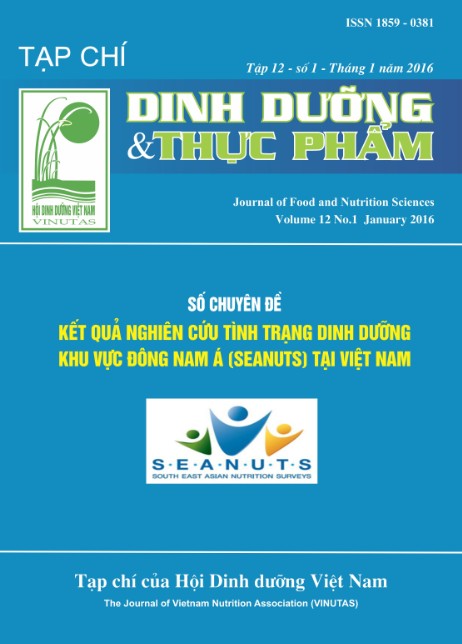STUDY ON THE RELATIONSHIP BETWEEN THE NUTRITIONAL STATUS AND IQ AMONG VIETNAMESE PRIMARY SCHOOL CHILDREN
Main Article Content
Abstract
Vietnamese children aged below 12 years are facing a double burden of malnutrition
with the simultaneous existence of both under and over nutrition. Their daily food intake
does not meet the Vietnamese RDA for a range of nutrients, especially of calcium and
vitamin D. This situation is known to affect the learning ability of children. Purpose of
this study is to find out if there is an association between nutritional status and IQ and
if so, how the relationship is. The analysis was done on 1893 primary school children
aged 6-11 years using a ordinal logistic regression model in detecting relationships between IQ (determined by Raven test) with nutrient intakes (assessed by 24 hour-recall
method for one most recent day) and nutritional anthropometry status. The statistics
were done on weighed data. The results showed that IQ had no relationship with current
nutrient intakes, whereas it had a positive relationship with age, HAZ, education of
mother and wealth index - those are indicators relating to long-term nutritional intakes
and nutritional status.
Keywords
IQ, nutrition, children
Article Details
References
2 Calvo M.S., Whiting S.J., Barton C.N. (2005). Vitamin D intake: a global perspective of current status. J. Nutr. 135 (2): 310–6.
3 Eyles D, Brown J, MacKay-Sim A, McGrath J, Feron F (2003). Vitamin D3 and brain development. Neuroscience ;118:641–53.
4 Ghazi1 H.F., Isa Z.M., Aljunid S., Tamil A.M. and Abdalqader M.A. (2012). Nutritional Status, Nutritional Habit and Breakfast Intake in Relation to IQ among Primary School Children in Baghdad City, Iraq. Pakistan Journal of Nutrition 11 (4): 379-382
5 Ghazi H.F., Isa Z.M., Aljunid S., Shah S.A. and Abdalqader M.A. (2013). Intelligence Quotient (IQ) Relationship with Energy Intake and Micronutrient Composition among Primary School Children in Baghdad City, Iraq. Pakistan Journal of Nutr. 12(2)200-204
6 Greenwood, C.E. and Craig R.E.A. (1987). Dietary influences on brain function: Implications during periods of neuronal maturation. Curr.Topics Nutr.Dis., 16: 159-216
7 Ivanovic, D., A. Almagia, T. Toro, C. Castro, H. Pe´rez, M.S. Urrutia, J. Cervilla, E. Bosch and R. Ivanovic (2000). Impact of nutritional status on brain development, intelligence and scholastic achievement in a multifactorial approach. La Educacio´n, 44: 3-35.
8 Lê Nguyễn Bảo Khanh, Lê Thị Hợp, Nguyễn Đỗ Vân Anh, Nguyễn Hữu Chính, Nguyễn Văn Long, Nguyễn Đình Dũng, Bùi Văn Tước (2012). Đánh giá tình trạng dinh dưỡng và một số yếu tố liên quan của học sinh phổ thông khu vực thành thị, nông thôn và miền núi. Đề tài NCKH cấp Bộ đã nghiệm thu theo QĐ 2579/QĐ-BYT
9 Khanh LNB, Hop LT, Anh NDV, Nga TT, Chinh NH, Do TT, Paul D., Ilse TK (2013). Double burden of undernutrition
and overnutrition in Vietnam in 2011: results of the SEANUTS study in o.5-11- year-old children. British Journal of Nutrition, 110, s45-s56
10 Lê Nguyễn Bảo Khanh, Paul Deurenberg, Lê Thị Hợp (2016). Thiết kế và
thực hiện SEANUTS tại Việt Nam. Tạp chí Dinh dưỡng và thực phẩm, Tập 12 số 1, 1/2016
11 Raven’s Progressive Matrices. http://education.pearsonassessments.com
12 Shariff JM., R.D. Jenny, T. Bond and N.E Johnson (2000). Nutrition and educational achievement of urban primary schoolchildren in Malaysia. Asia Pacific J. Clin.Nutr., 9: 264-273.
13 Sorenson M. (2013). Mental disoders sparked by vitamin D deficiency. Natural Health 365, copyright 2016.
14 Taras H.(2005). Nutrition and Student Performance at School. J Sch Health.;75(6):199-213]
15 Toga, A.W., Thompson PM. and Sowell, ER. (2006). Mapping brain maturation. Trends Neurosci., 29: 148-159.
16 Tổng Cục Thống kê (2010). Báo cáo kết quả tổng điều tra dân số và nhà ở năm 2009. NXB Thống kê
17 UNICEF (2006). Điều tra đánh giá các mục tiêu trẻ em và phu nữ (Multiple Indicator Cluster Survey-MICS).


